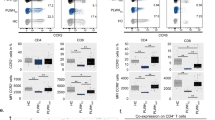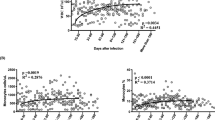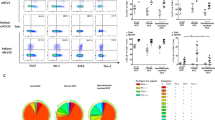Abstract
Circulating monocyte subsets with distinct functions play important roles in hepatitis C virus (HCV) infection. However, the mechanisms have not been well studied. In this study, we analyzed the distributions and phenotypic characteristics of three circulating monocyte subsets—CD14++CD16−, CD14++CD16+ and CD14+/dimCD16+—in chronic HCV-infected patients, HCV spontaneous resolvers and healthy controls, and we evaluated the possible link between HCV viremia and disease progression. Our results indicated that the frequency of the CD14++CD16+ monocyte subset was decreased, and negatively correlated with HCV RNA and core antigen levels during chronic HCV infection. PD-L1 expression and the PD-L1/CD86 ratio in CD14++CD16+ monocytes were higher during chronic HCV infection than in spontaneous HCV resolvers and healthy controls. The PD-L1/CD86 ratio positively correlated with HCV viral load and core antigen levels. Finally, PD-L1 was significantly increased, while cytokine secretions were dramatically decreased upon Toll-like receptor (TLR) ligand binding and HCV JFH-1stimulation. These findings indicates the compromised immune status of the CD14++CD16+ monocytes during chronic HCV infection and provides new insights into the specific role of the CD14++CD16+ monocytes and their significance in chronic HCV infection.
This is a preview of subscription content, access via your institution
Access options
Subscribe to this journal
Receive 12 digital issues and online access to articles
$119.00 per year
only $9.92 per issue
Buy this article
- Purchase on Springer Link
- Instant access to full article PDF
Prices may be subject to local taxes which are calculated during checkout





Similar content being viewed by others
References
Bowen DG, Walker CM . The origin of quasispecies: cause or consequence of chronic hepatitis C viral infection? J Hepatol 2005; 42: 408–417.
Bowen DG, Walker CM . Adaptive immune responses in acute and chronic hepatitis C virus infection. Nature 2005; 436: 946–952.
Hahn YS . Subversion of immune responses by hepatitis C virus: immunomodulatory strategies beyond evasion? Curr Opin Immunol 2003; 15: 443–449.
Hoofnagle JH . Hepatitis C: the clinical spectrum of disease. Hepatology 1997; 26: 15S–20S.
Claassen MA, Janssen HL, Boonstra A . Role of T cell immunity in hepatitis C virus infections. Curr Opin Virol 2013; 3: 461–467.
Liu B, Woltman AM, Janssen HL, Boonstra A . Modulation of dendritic cell function by persistent viruses. J Leukoc Biol 2009; 85: 205–214.
Tacke RS, Tosello-Trampont A, Nguyen V, Mullins DW, Hahn YS . Extracellular hepatitis C virus core protein activates STAT3 in human monocytes/macrophages/dendritic cells via an IL-6 autocrine pathway. J Biol Chem 2011; 286: 10847–10855.
Cros J, Cagnard N, Woollard K, Patey N, Zhang SY, Senechal B et al. Human CD14dim monocytes patrol and sense nucleic acids and viruses via TLR7 and TLR8 receptors. Immunity 2010; 33: 375–386.
van de Veerdonk FL, Netea MG . Diversity: a hallmark of monocyte society. Immunity 2010; 33: 289–291.
Ziegler-Heitbrock L, Ancuta P, Crowe S, Dalod M, Grau V, Hart DN et al. Nomenclature of monocytes and dendritic cells in blood. Blood 2010; 116: e74–e80.
Wedemeyer H, He XS, Nascimbeni M, Davis AR, Greenberg HB, Hoofnagle JH et al. Impaired effector function of hepatitis C virus-specific CD8+ T cells in chronic hepatitis C virus infection. J Immunol 2002; 169: 3447–3458.
Gruener NH, Lechner F, Jung MC, Diepolder H, Gerlach T, Lauer G et al. Sustained dysfunction of antiviral CD8+ T lymphocytes after infection with hepatitis C virus. J Virol 2001; 75: 5550–5558.
Huang X, Venet F, Wang YL, Lepape A, Yuan Z, Chen Y et al. PD-1 expression by macrophages plays a pathologic role in altering microbial clearance and the innate inflammatory response to sepsis. Proc Natl Acad Sci USA 2009; 106: 6303–6308.
Muhlbauer M, Fleck M, Schutz C, Weiss T, Froh M, Blank C et al. PD-L1 is induced in hepatocytes by viral infection and by interferon-alpha and -gamma and mediates T cell apoptosis. J Hepatol 2006; 45: 520–528.
Yao S, Wang S, Zhu Y, Luo L, Zhu G, Flies S et al. PD-1 on dendritic cells impedes innate immunity against bacterial infection. Blood 2009; 113: 5811–5818.
Shen T, Chen X, Chen Y, Xu Q, Lu F, Liu S . Increased PD-L1 expression and PD-L1/CD86 ratio on dendritic cells were associated with impaired dendritic cells function in HCV infection. J Med Virol 2010; 82: 1152–1159.
Geissmann F, Manz MG, Jung S, Sieweke MH, Merad M, Ley K . Development of monocytes, macrophages, and dendritic cells. Science 2010; 327: 656–661.
Ziegler-Heitbrock L . The CD14+ CD16+ blood monocytes: their role in infection and inflammation. J Leukoc Biol 2007; 81: 584–592.
Moniuszko M, Bodzenta-Lukaszyk A, Kowal K, Lenczewska D, Dabrowska M . Enhanced frequencies of CD14++CD16+, but not CD14+CD16+, peripheral blood monocytes in severe asthmatic patients. Clin Immunol 2009; 130: 338–346.
Zhang JY, Zou ZS, Huang A, Zhang Z, Fu JL, Xu XS et al. Hyper-activated pro-inflammatory CD16 monocytes correlate with the severity of liver injury and fibrosis in patients with chronic hepatitis B. PLoS ONE 2011; 6: e17484.
Han J, Wang B, Han N, Zhao Y, Song C, Feng X et al. CD14highCD16+ rather than CD14lowCD16+ monocytes correlate with disease progression in chronic HIV-infected patients. J Acquir Immune Defic Syndr 2009; 52: 553–559.
Auffray C, Sieweke MH, Geissmann F . Blood monocytes: development, heterogeneity, and relationship with dendritic cells. Annu Rev Immunol 2009; 27: 669–692.
Belge KU, Dayyani F, Horelt A, Siedlar M, Frankenberger M, Frankenberger B et al. The proinflammatory CD14+CD16+DR++ monocytes are a major source of TNF. J Immunol 2002; 168: 3536–3542.
Hijdra D, Vorselaars AD, Grutters JC, Claessen AM, Rijkers GT . Phenotypic characterization of human intermediate monocytes. Front Immunol 2013; 4: 339.
Tacke F, Randolph GJ . Migratory fate and differentiation of blood monocyte subsets. Immunobiology 2006; 211: 609–618.
Liaskou E, Zimmermann HW, Li KK, Oo YH, Suresh S, Stamataki Z et al. Monocyte subsets in human liver disease show distinct phenotypic and functional characteristics. Hepatology 2012; 57: 385–398.
Skrzeczynska-Moncznik J, Bzowska M, Loseke S, Grage-Griebenow E, Zembala M, Pryjma J . Peripheral blood CD14high CD16+ monocytes are main producers of IL-10. Scand J Immunol 2008; 67: 152–159.
Wong KL, Tai JJ, Wong WC, Han H, Sem X, Yeap WH et al. Gene expression profiling reveals the defining features of the classical, intermediate, and nonclassical human monocyte subsets. Blood 2011; 118: e16–e31.
Passacquale G, Vamadevan P, Pereira L, Hamid C, Corrigall V, Ferro A . Monocyte-platelet interaction induces a pro-inflammatory phenotype in circulating monocytes. PLoS ONE 2011; 6: e25595.
Freeman GJ, Long AJ, Iwai Y, Bourque K, Chernova T, Nishimura H et al. Engagement of the PD-1 immunoinhibitory receptor by a novel B7 family member leads to negative regulation of lymphocyte activation. J Exp Med 2000; 192: 1027–1034.
Okazaki T, Honjo T . The PD-1–PD-L pathway in immunological tolerance. Trends Immunol 2006; 27: 195–201.
Wang JM, Shi L, Ma CJ, Ji XJ, Ying RS, Wu XY et al. Differential regulation of interleukin-12 (IL-12)/IL-23 by Tim-3 drives TH17 cell development during hepatitis C virus infection. J Virol 2013; 87: 4372–4383.
Watanabe T, Bertoletti A, Tanoto TA . PD-1/PD-L1 pathway and T-cell exhaustion in chronic hepatitis virus infection. J Viral Hepat 2010; 17: 453–458.
Day CL, Kaufmann DE, Kiepiela P, Brown JA, Moodley ES, Reddy S et al. PD-1 expression on HIV-specific T cells is associated with T-cell exhaustion and disease progression. Nature 2006; 443: 350–354.
Rodig N, Ryan T, Allen JA, Pang H, Grabie N, Chernova T et al. Endothelial expression of PD-L1 and PD-L2 down-regulates CD8+ T cell activation and cytolysis. Eur J Immunol 2003; 33: 3117–3126.
Jeong HY, Lee YJ, Seo SK, Lee SW, Park SJ, Lee JN et al. Blocking of monocyte-associated B7-H1 (CD274) enhances HCV-specific T cell immunity in chronic hepatitis C infection. J Leukoc Biol 2008; 83: 755–764.
Abeles RD, McPhail MJ, Sowter D, Antoniades CG, Vergis N, Vijay GK et al. CD14, CD16 and HLA-DR reliably identifies human monocytes and their subsets in the context of pathologically reduced HLA-DR expression by CD14hi/CD16neg monocytes: expansion of CD14hi/CD16pos and contraction of CD14lo/CD16pos monocytes in acute liver failure. Cytometry A 2012; 81: 823–834.
Villacres MC, Literat O, DeGiacomo M, Du W, Frederick T, Kovacs A . Defective response to Toll-like receptor 3 and 4 ligands by activated monocytes in chronic hepatitis C virus infection. J Viral Hepat 2008; 15: 137–144.
Liu BS, Groothuismink ZM, Janssen HL, Boonstra A . Role for IL-10 in inducing functional impairment of monocytes upon TLR4 ligation in patients with chronic HCV infections. J Leukoc Biol 2011; 89: 981–988.
Martin-Blondel G, Gales A, Bernad J, Cuzin L, Delobel P, Barange K et al. Low interleukin-10 production by monocytes of patients with a self-limiting hepatitis C virus infection. J Viral Hepat 2009; 16: 485–491.
Peng C, Liu BS, de Knegt RJ, Janssen HL, Boonstra A . The response to TLR ligation of human CD16+CD14− monocytes is weakly modulated as a consequence of persistent infection with the hepatitis C virus. Mol Immunol 2011; 48: 1505–1511.
Dong H, Zhu G, Tamada K, Chen L . B7-H1, a third member of the B7 family, co-stimulates T-cell proliferation and interleukin-10 secretion. Nat Med 1999; 5: 1365–1369.
Hosiawa KA, Wang H, DeVries ME, Garcia B, Liu W, Zhou D et al. CD80/CD86 costimulation regulates acute vascular rejection. J Immunol 2005; 175: 6197–6204.
Nolan A, Kobayashi H, Naveed B, Kelly A, Hoshino Y, Hoshino S et al. Differential role for CD80 and CD86 in the regulation of the innate immune response in murine polymicrobial sepsis. PLoS ONE 2009; 4: e6600.
Tokita D, Mazariegos GV, Zahorchak AF, Chien N, Abe M, Raimondi G et al. High PD-L1/CD86 ratio on plasmacytoid dendritic cells correlates with elevated T-regulatory cells in liver transplant tolerance. Transplantation 2008; 85: 369–377.
Acknowledgements
This work was supported by the National Natural Science of China (81271826, 31100126), the National Science Foundation of Beijing (7122108), SKLID development grant (2011SKLID207) and grants from the National S&T Major Project for Infectious Diseases (2012ZX10002003 and 2012ZX10002005).
Author information
Authors and Affiliations
Ethics declarations
Competing interests
The authors declare that they have no competing financial interests.
Additional information
Supplementary Information accompanies the paper on Cellular & Molecular Immunology's website. (http://www.nature.com/cmi).
Supplementary information
Rights and permissions
About this article
Cite this article
Zheng, J., Liang, H., Xu, C. et al. An unbalanced PD-L1/CD86 ratio in CD14++CD16+ monocytes is correlated with HCV viremia during chronic HCV infection. Cell Mol Immunol 11, 294–304 (2014). https://doi.org/10.1038/cmi.2013.70
Received:
Revised:
Accepted:
Published:
Issue Date:
DOI: https://doi.org/10.1038/cmi.2013.70
Keywords
This article is cited by
-
Contradictory intrahepatic immune responses activated in high-load hepatitis C virus livers compared with low-load livers
Archives of Virology (2018)
-
Tissue-resident natural killer cells in the livers
Science China Life Sciences (2016)



